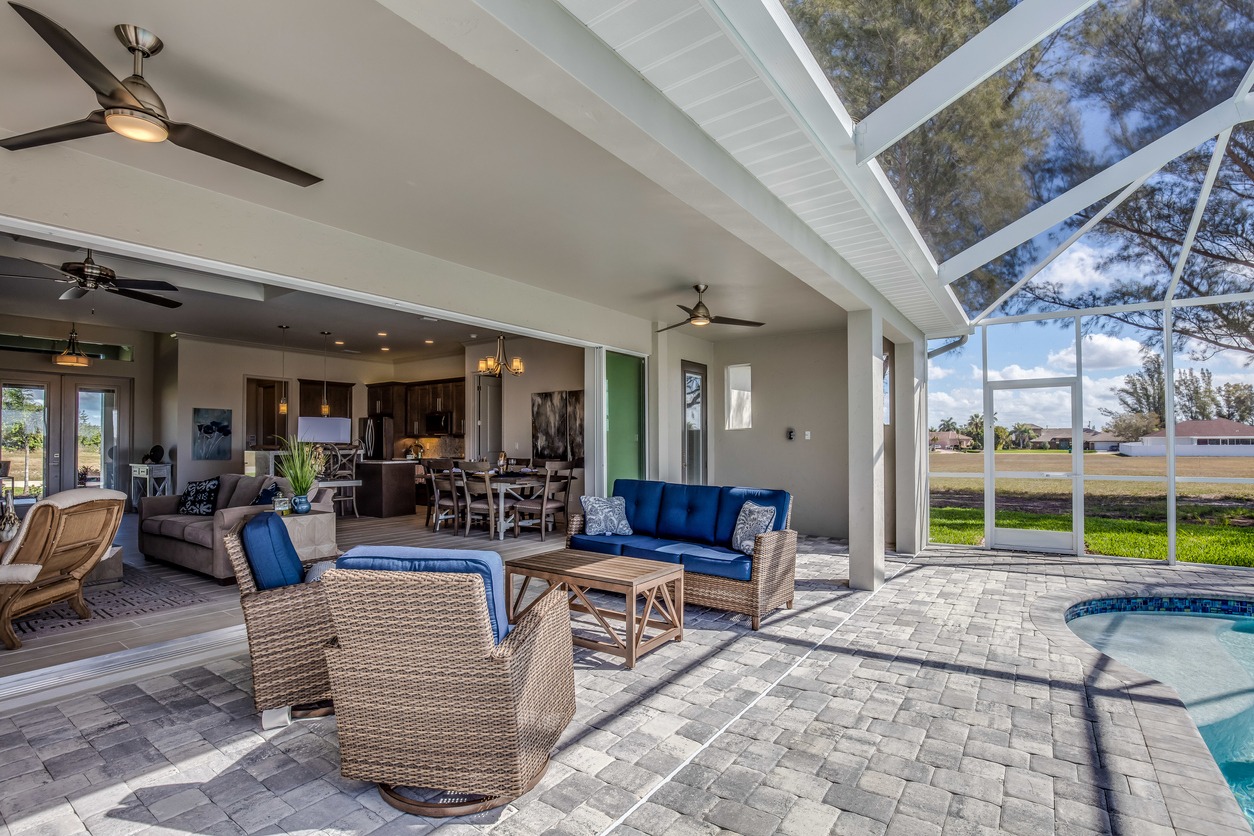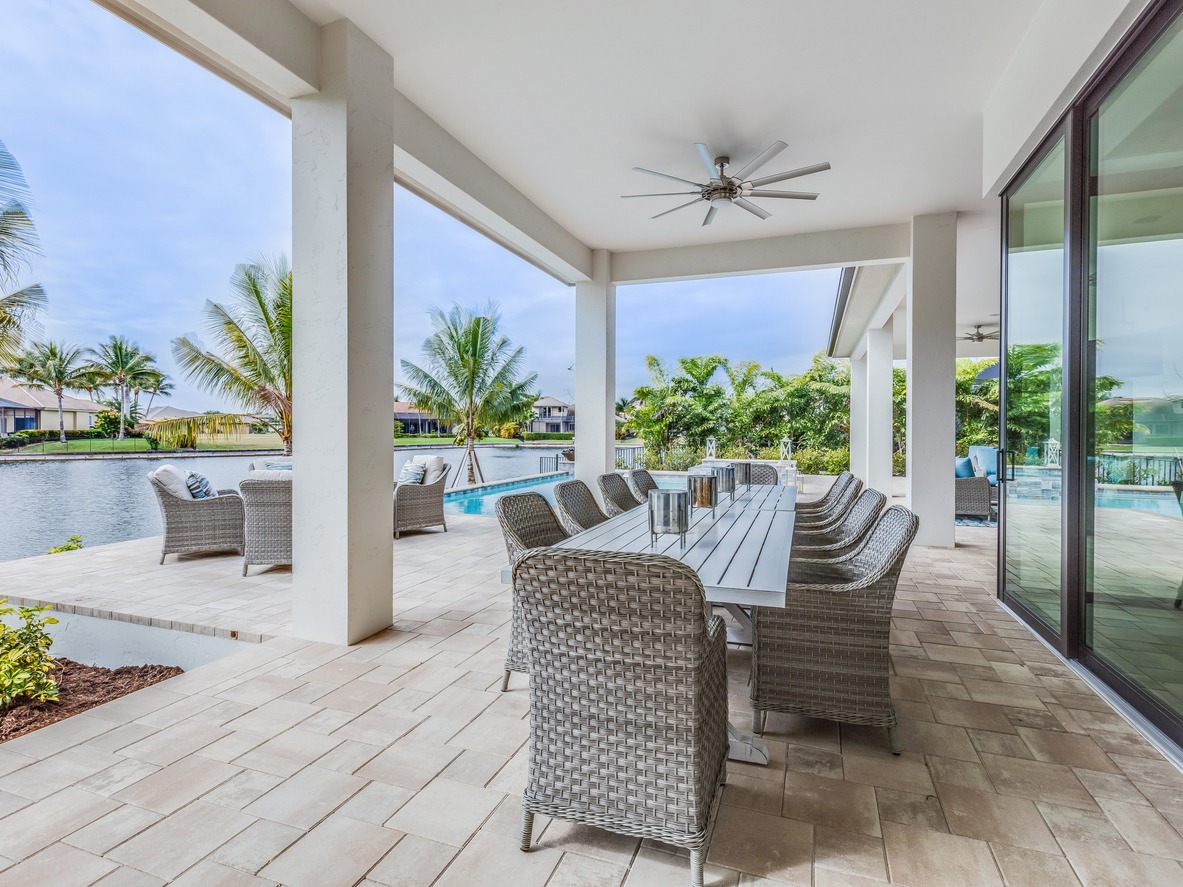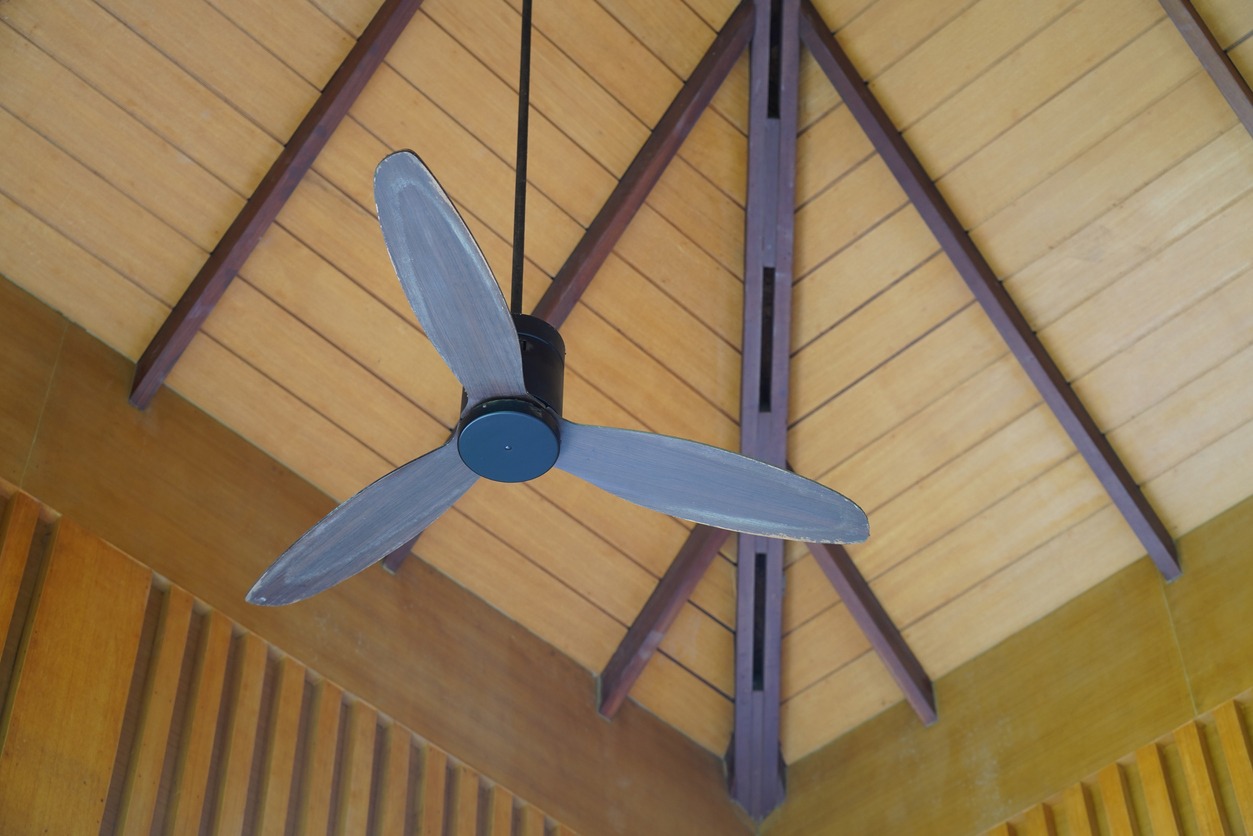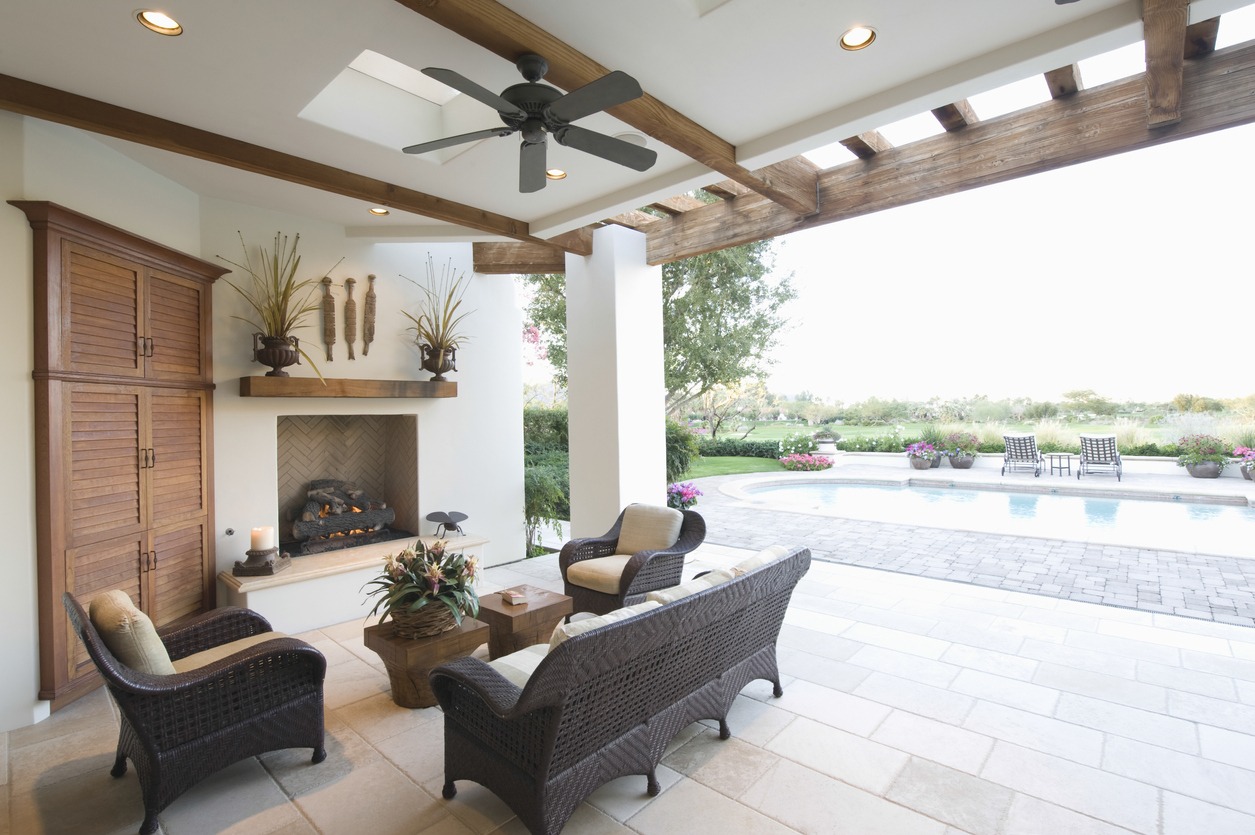An outdoor ceiling fan is similar to the ceiling fans that you can see inside most homes. However, they are specifically made to withstand the different environments in the patio, deck, and other outdoor living spaces in your home. Some of them offer features like all-weather fan blades that are made of plastic or other durable materials, along with waterproof and sealed motor casings. Some models also offer steel construction and specialized paint and metal finishes that help protect the parts of the ceiling fan to ensure cleaner operation over time.
Outdoor ceiling fans can be installed in covered outdoor areas in your house in order to help circulate air when there is not enough wind to keep things comfortable. They can add a personalized indoor look and style to any outdoor space. If you are thinking of installing outdoor ceiling fans on your patio or deck but don’t have any idea how to choose one, we are here to help you. In this post, we are giving you more information on everything you need to know about outdoor ceiling fans.
Different Types of Outdoor Ceiling Fans

The main purpose of an outdoor ceiling fan is to circulate air and generate a refreshing wind while you are outdoors. Therefore, finding one with the best design can make all the difference for your outdoor living areas. From installation height to blade size, the correct type of fan makes staying on the patio, porch, or deck a much more relaxing option for your whole family. To further understand your options, below are the different types of outdoor ceiling fans:
Standard Outdoor Ceiling Fans
Like the regular ceiling fan seen in living rooms and bedrooms, a standard outdoor ceiling fan is very common, and it features a motor and blades. Some of them hang from a thick rod that drops them closer to your living space. If you wish to spend more time on your porch, deck, or lanai before dawn or after dusk, installing a standard ceiling fan with a built-in light kit is ideal for you.
Outdoor Hugger Ceiling Fans
Hugger ceiling fans for outdoor use are flush-mounted and provide a low profile. They are best installed in small outdoor spaces that have low ceilings, such as screened-in porches and gazebos. These ceiling fans require at least seven to ten feet of space between the fan and the floor. Outdoor hugger ceiling fans are perfect in cozy outdoor areas of your home.
Lighted Outdoor Ceiling Fans
There are also outdoor ceiling fans that feature light kits. In fact, most outdoor ceiling fans today are already assembled, featuring the light mount, blades, fan controls, a variable speed motor, and the hardware needed to pull it all together. There are also some ceiling fans that come with controllers for both the fan and the lights.
UL Listings for Outdoor Ceiling Fans
If you are looking into installing some ceiling fans in your outdoor spaces, it is better to find those that are specifically made for outdoor use. There are ceiling fans that are made particularly to meet the UL ratings for outdoor use in order for them to stand up to humidity, salty sea breezes, and rain. To further understand this, below are the three main UL categories when it comes to ceiling fans:
Dry-Rated Ceiling Fans
Dry-rated ceiling fans are only used indoors and should not be used in your outdoor living spaces. Some might say that it is fine to place them outdoors, but this can be very dangerous. It’s because dry-rated ceiling fans are not equipped to withstand moisture or temperature changes. Aside from that, they are also subject to different mechanical issues when exposed to the elements outdoors. They are not built to deal with water and excessive heat, and using them outdoors may result in fire or other disastrous damage. Therefore, always remember that dry-rated ceiling fans are for indoor use only.
Damp-Rated Ceiling Fans
For covered patios, screened porches, sunrooms, and the lanai, damp-rated fans are the best option. They are suitable in outdoor living spaces that are not directly exposed to water, snow, or rain. These ceiling fans are able to handle a little humidity all year round.
Wet Rated Ceiling Fans
All outdoor ceiling fans in the market have a wet rating. This means that the fan has been equipped and tested to stand up to living areas that experience heavy rain, snow, and big ocean breezes. Wet-rated outdoor ceiling fans are strong enough to keep you cool during heat waves. Therefore, you need to look for a wet-rated ceiling fan if you are aiming to install it on sun-exposed gazebos, decks, pergolas, or verandas.
Where Are Outdoor Ceiling Fans Commonly Used?
Outdoor ceiling fans can be installed in any outdoor area in your home. From sunrooms to garages, as long as the space has electrical service, you’ll be able to install a ceiling fan in order for that space to benefit from added ventilation and airflow. If you are wondering where you can specifically place outdoor ceiling fans at home, below are some of the common living areas you can choose from:
Porch
Outdoor ceiling fans can add a decorative and functional feature to your home’s porch area. A ceiling fan on the porch is useful for moving air in the evening and cooling down an area during a sunny afternoon. They are also practical for any weather all year. The air movement that comes from the ceiling fan may help reduce humidity and heat in your porch area.
Garage
During the winter, having a heated garage is beneficial. However, when the summer season comes, it can also be great to have a ceiling fan in your garage, especially if you do not have air conditioning there. If you use your garage as storage, installing a ceiling fan may help reduce the humidity that may affect your belongings. If you often work in your garage, an outdoor ceiling fan can keep your garage cooler and more comfortable, especially for extended working hours.
Sunrooms
If you have a sunroom or a garden room, it could also benefit from the air movement brought by a ceiling fan. Since sunrooms are open rooms, they can provide your home a great ambiance as natural sunlight can get in while protecting you from the outdoor elements. However, since sunrooms often have large windows, they tend to let in and hold the heat, which leads to the temperature inside to rise. But installing a ceiling fan will help in regulating the temperature in your sunroom better and make it usable year-round.
Pergola
Even in living areas that are open on all sides, such as a pergola, a ceiling fan can be beneficial, especially in the dead of the summer. It will help keep the air moving through the open space. When the weather gets hot and humid, it is not ideal for sitting outdoors. But if you have an outdoor ceiling fan, you will be able to enjoy sitting outdoors while feeling comfortable with the gentle breeze that the ceiling fan brings.
Aside from these areas, you can install outdoor ceiling fans in any semi-open space that you may have at home, such as verandas, patios, and other entertaining areas. They are beneficial for circulating air, reducing heat, and decreasing humidity.
Outdoor Ceiling Fan Sizes
It is common for outdoor ceiling fans to have five blades. But some come in three or four blades, while others are as many as 15 blades. But which of them do you think is best to be installed in your outdoor living space? Remember that maximum fan size does not always mean maximum airflow. There are factors that affect the airflow of an outdoor ceiling fan, such as the pitch speed, blade span, and distance from the floor.
When choosing an outdoor ceiling fan for a small space, avoid picking overly large fans, as you will have far too much wind to be comfortable. On the other hand, if you have a bigger outdoor space, such as a wide porch, you might need a bigger ceiling fan or two or more regular ceiling fans in order to circulate air well.
The space between blades helps in creating air movement. Therefore, it is best to look for ceiling fans that have shaped blades and very little overlap to push air around. Also, while adding blades will adjust the airflow, it will also add to the noise because the air circulates, and the fan motor works tougher. Having a noisy ceiling fan can be distracting in social spaces, whether indoors or outdoors.
Below are some of the factors you need to consider when it comes to the size of outdoor ceiling fans:
Blade Span
The span of the blade of a ceiling fan is also sometimes referred to as blade sweep. It refers to to the measurement from the end of one fan blade to the end of the blade straight across from it. Blade span is the diameter of the circle the fan makes when it is operating. Compared to short blades, long blades can move more air. In a large space, installing multiple well-placed smaller ceiling fans can provide a more effective airflow than placing one huge ceiling fan.
Blade Pitch
The angle of the ceiling fan’s blades is called the blade pitch. This affects the size of the motor that the ceiling fan needs in order to circulate air in your outdoor space. Ceiling fans that have flatter pitches can move less air than fans with steeper pitches. Even though ceiling fans with flatter pitches spin fast, they still move less air.
Outdoor Ceiling Fan Materials
There are various materials used in making outdoor ceiling fans, and these may also affect their size. They can be made from a number of durable materials, such as composite plastic, natural wood, and metals. The housing of the motor can match the color of the blade, but there are also finishes that complement each other. The most popular motor housing finishes for outdoor ceiling fans are white, silver, nickel, and bronze. Blade finishes, on the other hand, usually come in light wood, dark wood, black, white, and everything in between.
Things to Consider When Choosing an Outdoor Ceiling Fan
There is a wide range of styles that may complement your home when it comes to outdoor ceiling fans. There are modern and contemporary, transitional, rustic, and traditional ceiling fans that are popular today. You also have the option to be more style-specific with tropical, farmhouse, Southwestern, and nautical styles. In order to choose the best outdoor ceiling fans for your home, below are some of the things that you may want to consider:
Accessories
You have the option to purchase a complete outdoor ceiling fan with lights in a kit that includes everything you need. But there are times when accessories are still needed. You might need individual accessories or parts, such as a downrod to handle the fan from a high ceiling, an angled adapter for ceilings that are not flat, or a separate light kit if you want a customized light for your ceiling fan.
Motor Types
Outdoor ceiling fans usually have two different motor types, but they are still installed into the ceiling the same way. One of them is the AC motor. Outdoor ceiling fans with AC motors acquire their energy from alternating current through the electrical system of your home. Installing a ceiling fan requires electrical work, and it is better that it is done by a professional electrician to avoid any issues and accidents.
The other type of ceiling fan motor is the DC motor. Ceiling fans with this type of motor get a direct current, such as batteries, from a built-in AC-to-DC power converter. These ceiling fans are more energy efficient, making them great for garage ceiling fans that run for long periods. DC motors control the fan differently compared to AC motors. It allows for a wider variety of airflow settings, and it is usually quieter.
Fan Controls
Outdoor ceiling fans often have a pull chain, wall control, remote control, or a combination of all of these to allow you to manage their power, lights, and speed. Outdoor ceiling fans with pull chains are classic, and they require you to pull a short chain to control the fan speed and the lights.
Remote control ceiling fans allow users to control the fan and the lights from anywhere within range. It is a great option if you have a high ceiling in your outdoor area that is not easy to reach. Lastly, wall-control ceiling fans require users to use a switch on the wall to turn them on and off or to change the speed of the fans and the brightness of the light.
Bulb Types
If you are aiming to get a ceiling fan with lights for your outdoor spaces, note that some bulbs are more energy efficient compared to others. They also produce various types of lights. For instance, ceiling fans that feature LED bulbs use less electricity, and they are available in different color temperatures. Fluorescent bulbs, on the other hand, are inexpensive to run and can provide bright illumination.
There are also compact fluorescent bulbs that are made in special shapes that fit in standard light sockets. They can provide your ceiling fan with more aesthetic appeal. Aside from these, other bulb types that you can choose from include incandescent bulbs, halogen bulbs, and xenon or krypton bulbs. However, incandescent light bulbs and CFLs are phasing out, and LED lights are the most common bulbs that many ceiling fans today have.
Benefits of Installing an Outdoor Ceiling Fan
A lot of people may not think of installing a ceiling fan in spaces outside of their houses. But did you know that outdoor ceiling fans come with many benefits, particularly during the summertime? If you are wondering what benefits these are, read on below:
Keeps Your Outdoor Spaces Cool
During the summer season, the heat can be on full blast. But when you have an outdoor ceiling fan installed in your outdoor living areas, like your porch or deck, you will be able to enjoy summer days with a nice breeze while spending time in these areas.
Help Save Energy
Installing an outdoor ceiling fan may also help in reducing the amount of energy your home uses. It’s because a high-powered ceiling fan consumes less energy compared to an outdoor air conditioner.
Provide Lighting
When the temperature cools down in the evening, it is great to enjoy a glass of wine on your patio. Many ceiling fans come with the option of added lighting, which is more convenient compared to installing lamps around your outdoor spaces. A ceiling fan with lights will make your patio look neat and not cluttered.
Ward Off Pests
Installing an outdoor ceiling fan may also help in stopping bugs and insects from bothering you when you are relaxing outdoors. The wind from the fans will make it more difficult for bugs to fly through, which can make your outdoor area more comfortable to stay in.
Customizable
Ceiling fans for outdoor use come in a wide variety of sizes, styles, and materials. You can also choose from different modern, luxe, or industrial ceiling fans, as well as pick from a number of blades, colors, and sizes. This means that outdoor ceiling fans can help you create a beautiful area for your outdoor living space.
Conclusion
Outdoor ceiling fans are indeed a great addition to any outdoor living space, as they can provide a comfortable and stylish way to keep cool, especially during hot weather. If you are planning to install a ceiling fan in your outdoor areas at home, make sure that you are choosing either damp-rated or wet-rated ceiling fans, and never use dry-rated ones outdoors to prevent dangerous scenarios.
By choosing the right ceiling fan and following the proper installation and maintenance procedures, you will be able to enhance your outdoor living experience and enjoy your outdoor spaces at home, even during hot, sunny days. We hope this post helped you learn more about outdoor ceiling fans.





